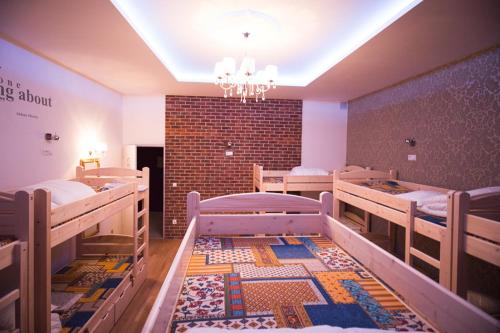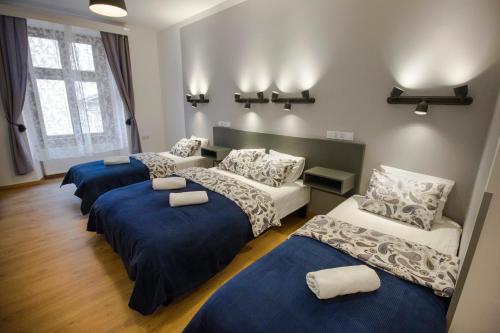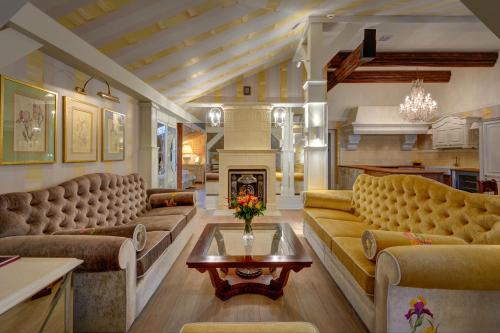One step after another.
Bit by bit, metre by metre, that’s how they built this enormous underground complex. And that’s also how you visit the Wieliczka Salt Mine – with 810 steps to get to the bottom of the tourist route, deep in the bowels of the earth.
This is no ordinary mine, not just a warren of small dark tunnels and dangerous industrial pitfalls. The Wieliczka Salt Mine is a small city, an art gallery, a place of work, and a house of worship… and it’s all carved out of salt.
First used in the 13th century, the Wieliczka Salt Mine was one of the most significant industrial centres for Poland – a driving force in the local economy and one of the main employers of the region
And since work stopped here in 1996, it has become one of Poland’s most popular tourist attractions and one of the country’s greatest sources of pride, with a story that goes to the heart of the national character.
Why is the Wieliczka Salt Mine important?
For a large part, the fame of the Wieliczka Salt Mine comes from its spectacular appearance, filled with statues, chandeliers, and other decorations. But Wieliczka has also been named a World Heritage Site because it shows the development of mining techniques in Europe from the 13th to the 20th centuries.
Is the Wieliczka Salt Mine still active?
Although Wieliczka Salt Mine was in use for centuries, from as early as the 1200s, operations declined in the 20th century and the final commercial salt extraction took place in 1996.
Can you visit the Wieliczka Salt Mine?
The underground labyrinth of tunnels is enormous and you can’t see it all – you wouldn’t even have time to! But parts are open and you can visit them on one of the public tours of Wieliczka Salt Mine.
One of the things that makes the Wieliczka Salt Mine so impressive is its size.
After 700 years of continuous operation, the site ended up reaching a depth of 327 metres, with more than 240 kilometres of galleries and 2350 chambers!
The easiest way to visit Wieliczka Salt Mine is with a tour from Krakow, and I would recommend this excellent trip that includes hotel pickup.
But beyond that, it’s the beauty of these galleries and chambers that makes Wieliczka so special. Carved with care and decorated with pride, the complex is more than just utilitarian.
Generations of miners have left a remarkable legacy.
Visiting the Wieliczka Salt Mine takes you deep into the underground city, through a fair amount of the important parts. But, of course, you’ll only ever see a small fraction of those 240 kilometres of galleries.
But it’s clear to see why this was one of the first places to be added to the UNESCO World Heritage List – one of just 12 that made up the list in its very first year.
Below, I have lots of tips for how you can see inside the Wieliczka Salt Mine yourself. First, though, I want to briefly cover some of the background.
History of the Wieliczka Salt Mine
For the miners who worked underground, the tunnels and caverns were a second home and they took great pride in treating it as such.
Although humans extracted salt from springs here as early as the Neolithic era, it was the discovery of rock salt in the 13th century that led to the first shafts being dug.
Even from those early years of operation in the 13th century, workers began to decorate Wieliczka Salt Mine with statues. Carved out of salt, the artwork gave life and spiritual meaning to the catacombs.
The underground network grew over the years and by the 15th century, Wieliczka was the country’s largest source of salt and was internationally famous.
Pockets that the workers mined became rooms and many of those rooms became chapels. Religious iconography and altars gave them places to ask for guidance and help.
When you spend so many hours a day so far underneath the ground, it’s important to have a direct line to the heavens.
Work within the mine was pretty much continuous for centuries, and eventually, hundreds of kilometres of tunnels and chambers were dug beneath the ground.
When you visit the Wieliczka Salt Mine today, you’ll see examples of how the technology changed over the years, but most of the rooms look similar.
By the 20th century, though, things were starting to shift quite markedly for the mine. It was occupied by the Germans in World War II and used for wartime production.
And then post-war, people started to see the opportunity for tourism and new visitor infrastructure was added, including a horse-drawn railway in the tunnels.
In the end, the economics of salt mining didn’t really make sense anymore – and the financial benefits of tourism seemed to have the most potential.
Commercial mining finished in 1996 and Wieliczka Salt Mine was formally declared closed.
What to see at the Wieliczka Salt Mine
“There are two thousand chambers in the mine”, our guide tells us. That’s hard to imagine.
“You are only seeing one per cent on our tour.” That’s hard to believe.
“To see it all would take more than seven weeks.” That’s hard to walk!
Thankfully, on a tour of Wieliczka Salt Mine, you’ll be taken to all the important places, so there’s no need to do any planning, but it is interesting to know what you’ll see.
When I visit the Wieliczka Salt Mine, I do the Tourist Route, which takes me along more than 2.5 kilometres – down staircases, through small chambers, into cavernous halls, past chapels, around lakes and finally into a tiny elevator that carries us back up to the top in seconds.
(It was nice to see daylight again although I’d almost forgotten how far I was underground. I suppose that was the whole point of the wonderland the miners built over all those generations.)
Anyway, here are some of the best things you’ll see at Wieliczka Salt Mine:
St Kinga’s Chapel
Definitely the highlight of the mining complex, St Kinga’s Chapel is the largest of the chapels you’ll see underground here.
It took three men the course of 67 years to decorate, chiselling and sculpting artwork from the salt. Today it has large chandeliers hanging from the roof and can be used for weddings and other ceremonies.
Although the carved altar at the far end is the focus, also take note of the artworks that are on the walls on either side, placed as they might be if they were framed paintings.
From floor to ceiling, St Kinga’s Chapel is 12 metres high… and all of this is about 100 metres below the surface.
Salt sculptures
You’ll visit about 20 chambers on the standard Tourist Route tour of Wieliczka Salt Mine, and there are beautiful salt sculptures in many of them, especially in the St Anthony, Janowice, and Holy Cross Chapels.
These artworks span centuries, with many of the older ones related to religious stories or historical legends (including a tableau related to St Kinga).
And then there are more modern salt sculptures, including a famous one of Nicholas Copernicus that was unveiled in 1973 on the 500th anniversary of his birth.
Mining work
It’s not all about the art underground, and you’ll also visit some rooms that show how the mining industry evolved over the centuries.
You’ll see where the horses were kept back when they were used to pull carts, and the railway tracks that later replaced them.
In the Spalone Chamber, for instance, you’ll learn about the people whose task it was to burn the methane before its concentration led to an explosion… of course, if there was already too much there, then… yikes.
Underground lakes
There are a number of lakes within the mine complex and, although they appear eerily black underground, they create a beautiful effect by reflecting the lights around them.
One of the most beautiful lakes is in the Weimar Chamber, which has an illuminated staircase down the side of a wall.
Apparently, it’s so romantic that there have been a number of marriage proposals beside the water!
Carpentry structures
And another thing I think is really interesting is the enormous carpentry structures that have been built in some of the chambers to keep the mine from collapsing.
Although they serve a practical purpose, like much of the mine complex, consideration has also been given to the aesthetics, which is one of the reasons you’ll see beautiful chandeliers hanging beside some of them, for example.
As well as these highlights of Wieliczka Salt Mine, it’s also interesting to see how many of the rooms can be used today.
There are function rooms, conference facilities, restaurants and bars that are available for hire. The city underground may not be a working mine anymore but it still has life.
Visiting the Wieliczka Salt Mine
Most people will visit the Wieliczka Salt Mine from Krakow and that’s what I would suggest you do if you’re spending a few days in this part of Poland.
If you don’t have a car, you can get out there by public transport, which is easy enough but involves a bit of planning. Otherwise, there are lots of tour companies that include transfers from the city centre or your hotel.
Because there are only limited spaces each day, I would recommend booking an entry ticket in advance. If you book through this company, you’ll be able to skip the line, and they can also include transport.
Some other good options for tour companies that will arrange tickets and transport from Krakow to the Wieliczka Salt Mine are here:
It’s a little cheaper to arrange all your own transport and book directly through the site itself, rather than use a local tour company, and you can do that here.
Everyone who visits Wieliczka Salt Mine has to go with a guide on a predetermined route.
The standard tour that most people will do (and I would recommend for first-time visitors) is called the Tourist Route. It takes you to all the main sights underground and is relatively easy.
The other option is called the Miners’ Route. It goes to lesser-visited areas that aren’t quite as spectacular but you get a more authentic experience of what it was like to live and work down here – even using a lamp to see at times.
With either option, even though you’ll only see a tiny fraction of the tunnel network, the guided tour of Wieliczka Salt Mine will take about two and a half hours.
There’s lots of walking and quite a few steps, so wear comfortable shoes. (For the Miners’ Route, you have to wear enclosed shoes, so no flip-flops or sandals are allowed!)
A few other useful bits of information for visiting the Wieliczka Salt Mine:
- There is very limited phone reception underground (if any) but there is wifi available.
- The temperature underground is about 18 degrees, so you may want to bring something warm with you.
- Photography and filming are allowed in the Wieliczka Salt Mine.
- Children of any age can take the Tourist Route – but they need to be at least 10 to do the Miners’ Route.
For people with accessibility issues who can’t do the standard tour, there are adapted tours that require less mobility, but they only run during the first and last hours each day and need to be booked in advance.
Where is the Wieliczka Salt Mine?
The Wieliczka Salt Mine is about 12 kilometres southeast of central Krakow. The official address is Daniłowicza 10, 32-020, Wieliczka.
You can see it on a map here.
How do you get to the Wieliczka Salt Mine?
It’s quite easy to get to the Wieliczka Salt Mine from Krakow by public transport. By train, you can go directly from Krakow Główny station to Wieliczka Rynek Kopalnia and it’s just a short walk from there.
By bus, catch number 304 from Dworzec Główny Zachód to Wieliczka Kopalnia Soli.
If you’re driving, there’s lots of parking at the site for 30 zł (US$7.50) per car.
Most tours from Krakow will include a transfer from your hotel or the city centre.
What are the Wieliczka Salt Mine opening hours?
You can go into the Wieliczka Salt Mine on one of two tours.
The Tourist Route tour is open from 9:00 – 17:00 with English tours every 30 minutes.
The ‘Miners Route’ is open from 9:00 – 15:00 with English tours at 10:15 and 14:15.
How much is the Wieliczka Salt Mine entry fee?
You can go into the Wieliczka Salt Mine on one of two tours. They each cost the same.
General: 128 zł (US$32.25)
Concession: 108 zł (US$27.20)
Family (2 adults/2 children): 386 zł (US$97.20)
Are there tours to the Wieliczka Salt Mine?
Once you reach the site, the only way to go into the mine is on one of the official guided tours that leave regularly.
There are also good tours from Krakow that will take care of your transportation from the city, such as this half-day trip.
Another popular option is this full-day tour from Krakow which also includes a visit to Auschwitz-Birkenau.
For food, there are two options at the mine.
Once your tour has finished, you can grab a Polish meal at the underground restaurant Karczma Górnicza, located 125 metres beneath the surface, before you come back up. (You can also just get a coffee or drink there.)
Or on the surface next to the Daniłowicz Shaft, there’s Bistro Posolone, which serves a range of standard international food like burgers and pasta.
Of course, there are lots of other things to do in Krakow, but I would make sure to leave time to visit the Wieliczka Salt Mine.
Another tour that I would recommend is to the Auschwitz concentration camp, which will be quite confronting but I think is important to see for yourself.
THE BEST ACCOMMODATION IN KRAKOW
I would recommending staying in the Old Town, where you’ll find lovely hotels and be right amongst the sights.
BACKPACKER

There’s a lively party atmosphere at Greg & Tom Beer House Hostel, where you’ll get free breakfast and dinner, plus a special beer hour!
BUDGET

Clean and cozy and in a central location, Pokoje Gościnne Św. Anny offers great value for money for an affordable stay.
BOUTIQUE

In a historic building with a refreshed interior, Bonerowski Palace has wonderful views from its location right next to the main square.
LUXURY

In a perfect location, the beautiful Bachleda Luxury Hotel even has an indoor pool, spa, and a free breakfast.
Time Travel Turtle travelled to Poland as a guest of the Polish National Tourist Office but the opinions, over-written descriptions and bad jokes are his own.
When I was in Poland a few years ago, I heard about this place but never had a chance to go. Reminds me of the Karst caves in Slovenia (even though this one is about salt). Very interesting though. I can’t believe how big it is!
Oh, that’s a pity you didn’t get there. It’s quite amazing. I hadn’t heard of the Karst Caves but if it’s anything like this mine then I’m definitely going to try to get along there myself now!
How cool that they have chapels down there. Looks like a fun place to see!
Some of the chapels are huge! It’s a really fun place to visit – you never quite know what to expect in the next room but it always surprises.
Turtle, that’s amazing! Like a terrifying underground counterpoint to the mental Tennessee treehouse.
I hope you resisted the urge to lick it.
I hadn’t thought about the parallels with the treehouse but they’re definitely there. Imagine the treehouse was on top of the mine and there was an elevator between them. Blow. Your Mind!
(And, no, I couldn’t resist)
I want to visit this place sounds really good kind..Thanks for sharing with us..
My pleasure. It’s a fascinating place!
This is really great place. I was 14 years old when I veiitsd it and it still engraved in my mind. One of the most impressive things I have seen in Poland.Tanks for posting it, Lauren.
Very fascinating. Working in a mine is incredibly hard, my parents visited years ago the coal mines in France where my grandfather used to work, some 1000mt underground, breathing dangeours dust all the time and with the constant danger of an accident or a collapse. I was less than 18 so I wasn’t allowed, but they came up completely dirty, I can only imagine my grandfather going down there every day.
Oh, wow. I can only imagine how much more it would mean to visit a mine when you have a family history like that. It’s hard to know what it was like for the workers but at least in this case they seem to have made the best of it that they could.
I’ve yet to see the Wieliczka salt mines. Next time in Krakow… Really good photos!
You should definitely put it on the list of places to go to. It was quite an experience. Do you get to Krakow often?
So cool, thanks for sharing this!
My pleasure. It was such a cool place – how could I not want to share it with everyone!
I just love your blog. You’re so talented.
Ha ha… thanks Franco. You still in BA?
Really cool photos and the description of the mine 😉
It’s hard not to take cool photos there. Everything is so breath-taking!
As imagined, a nice trip. I suggesting too ”Basilica Zystern” in Istanbul/Turkey. Absolutely should see
Oh, wow – thanks for the tip! I’ll definitely check it out if (when) I get to Turkey…
You will not regret. Istanbul has various Historical heritage. You can find traces of Roman and Ottoman culture. So, Good one choose.
This is really just breathtaking… I mean, salt!!!! Wow. I can’t imagine that it’s just such a normal part of life for the locals (hiring a conference room?!).
That’s the thing that is so amazing. It’s stunning enough just to look at but then you think about how it’s all made out of salt — Awesome!
That looks like an absolutely amazing site to see. That’s the first time I’d heard of it. Is there only one entrance?
There’s only one main entrance that they use these days. But it stretches for kilometres in each direction so there must be other ways in and out.
I’d love to visit Poland someday. I’m allcatuy adding this on my bucket list. Number 24 Visit Poland. How I envy you. I have always been fascinated by Polish traditions and culture, not to mention the friendly people and breath-taking places. And the food!!! I’ve always wondered how they taste like what’s the pink food? How does it taste? sigh**Marvin
It’s amazing at the complex structures that civilizations could form, even before the modern machine age. The more discoveries that are made the more amazing stuff seems to pop up around the world.
I honestly don’t know how they could create something like this with the old tools they must have been using. You’re right – it does make it even more impressive!
what camera did you use? excellent pictures considering light conditions.
Thanks Steve. I don’t consider myself to be much of a photographer. I use a Canon 600D with the kit lens… and it’s normally on automatic too! 🙂
I just saw a pic of the Salina Turda yesterday for the first time, and now I see a salt mine from you too! So impressive! I have been enjoying your travel blogs!
Thanks, Mel! The salt mine is a really impressive place. I hope you get a chance to see it for yourself one day!
What a cool place to visit! I wonder how they manage to keep the fresh air flowing, considering that many more people go there on the daily basis.
In my opinion Wieliczka Salt Mine is one of the most beautiful places in Poland, I love it! Stunning place that everybody should visit 🙂
I agree – a really stunning place and definitely worth the visit!
I’d love to go here some day. .